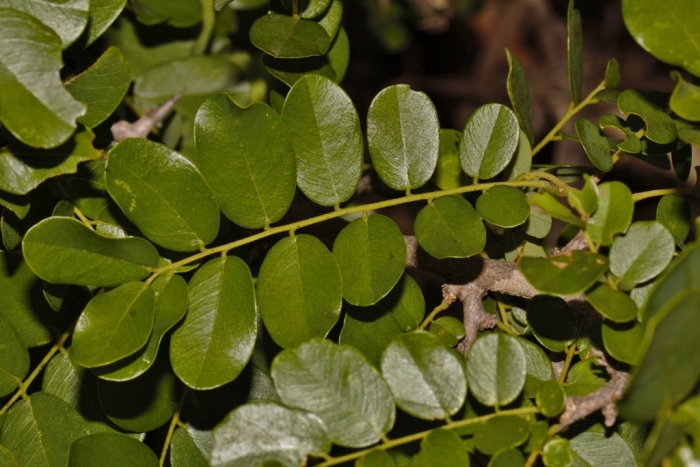African Blackwood
(Dalbergia melanoxylon)
African Blackwood (Dalbergia melanoxylon)
/
/

i_c_riddell
CC BY 4.0
Image By:
i_c_riddell
Recorded By:
Copyright:
CC BY 4.0
Copyright Notice:
Photo by: i_c_riddell | License Type: CC BY 4.0 | License URL: http://creativecommons.org/licenses/by/4.0/ | Rights Holder: i_c_riddell | Publisher: iNaturalist | Date Created: 2018-01-12T11:40:30-08:00 |
























Estimated Native Range
Summary
Dalbergia melanoxylon, commonly known as African Blackwood or mpingo, is a deciduous small tree or shrub native to the seasonally dry regions of the savanna woodlands and rocky hills in Africa, stretching from Senegal to Eritrea, and south to Mozambique and northeastern South Africa. It typically grows to a height of 13-49 feet (4-15 meters) and has a distinctive appearance with grey, often flaky bark and spiny shoots. The leaves are pinnately compound, and the tree produces inconspicuous pale yellow to white flowers, followed by oblong, brown seed pods. The flowering season occurs between November and February, and while the flowers are not particularly showy, they are of ecological importance to native pollinators.
African Blackwood is highly valued for its extremely dense and dark heartwood, which is used in the manufacture of musical instruments such as clarinets, oboes, and bagpipes, as well as in fine furniture and carving. The wood’s fine grain and ability to be polished to a high luster make it a preferred material for detailed work. In cultivation, it requires a hot, dry climate and can tolerate poor soils, but it is not commonly grown in gardens due to its slow growth rate and conservation concerns. Overharvesting for its valuable wood and low natural germination rates have led to its status as a threatened species. Sustainable harvesting and replanting initiatives are critical for its conservation. It is not typically associated with aggressive roots or significant disease problems, but its rarity and conservation status limit its use in cultivation.CC BY-SA 4.0
African Blackwood is highly valued for its extremely dense and dark heartwood, which is used in the manufacture of musical instruments such as clarinets, oboes, and bagpipes, as well as in fine furniture and carving. The wood’s fine grain and ability to be polished to a high luster make it a preferred material for detailed work. In cultivation, it requires a hot, dry climate and can tolerate poor soils, but it is not commonly grown in gardens due to its slow growth rate and conservation concerns. Overharvesting for its valuable wood and low natural germination rates have led to its status as a threatened species. Sustainable harvesting and replanting initiatives are critical for its conservation. It is not typically associated with aggressive roots or significant disease problems, but its rarity and conservation status limit its use in cultivation.CC BY-SA 4.0
Plant Description
- Plant Type: Tree
- Height: 15-30 feet
- Width: 20-30 feet
- Growth Rate: Slow
- Flower Color: Brown, White
- Flowering Season: Spring, Summer, Fall
- Leaf Retention: Deciduous
Growth Requirements
- Sun: Full Sun
- Water: Medium
- Drainage: Fast, Medium
Common Uses
Low Maintenance
Natural Habitat
Savanna woodlands and rocky hills
Other Names
Common Names: Grenadilla, African-Ebony, Chinese Blackwood, Mozambique-Ebony, Senaar-Ebony, Senegal-Ebony, Mpingo, Sudan-Ebony
Scientific Names: , Dalbergia melanoxylon, Amerimnon melanoxylon, Amerimnon stocksii, Dalbergia stocksii,
GBIF Accepted Name: